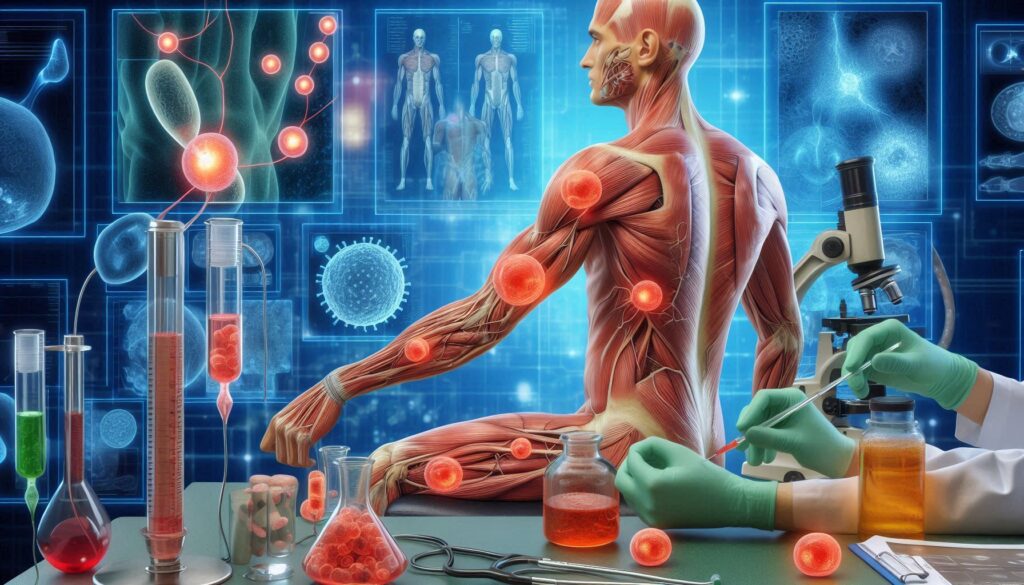Neuro Disorder
Organ Specfic
Orthopadic
Stem Cell Therapy
- Umbilical Cord Tissue Stem Cell
- Stem Cell Therapy Safety and Risks
- Mesenchymal Stem Cell Therapy
- Stem Cell Therapy Limitations
- Adipose Tissue diseases Stem Cell
- Bone Marrow Stem Cell
- Induced Pluripotent Stem Cell
- Why India for stem cell treatments?
- Stem Cell Treatment of ATAXIA in Delhi, India
- Limitations of Stem Cell Treatment

Stem cells sourced from umbilical cord tissue are a very interesting type of stem cell; they exist in the connective tissue (Wharton’s jelly) that surrounds the blood vessels in the umbilical cord. They have attracted a lot of interest in the medical research community and show extensive potential for therapeutic use.
Umbilical Cord Tissue Stem Cells: The Origin and Traits
Umbilical cord tissue stem cells are classified as mesenchymal stem cells (MSCs) and are therefore capable of differentiating into a number of cell types, such as bone, cartilage, fat, and muscle cells, to name a few. What is so fascinating about these stem cells is that their source is the gelatinous connective tissue of the umbilical cord, which is normally disposed of after childbirth. Their collection method is non-invasive and more straightforward than other sources of stem cells, which can be more involved and/or invasive.
Benefits of Using Umbilical Cord Tissue Stem Cells
Umbilical cord tissue stem cells offer several advantages as a potentially useful area of research and therapy:
- Higher Proliferation Rates: Compared to adult stem cells, umbilical cord tissue stem cells have shown more rapid proliferation rates, making them easier to expand in the lab for research and therapeutic purposes.
- Decreased Immune Rejection: By reason of their immature immunologic properties, umbilical cord tissue stem cells are less likely to elicit an immune rejection response from the recipient, which lowers the likelihood of associated complications.
- Ethics: Unlike embryonic stem cells, which are derived from human embryos, umbilical cord tissue stem cells are obtained from an uncontroversial source and thus are more ethically favorable for study and therapy.
Potential Uses for Umbilical Cord Tissue Stem Cells
The unique and versatile characteristics of umbilical cord tissue stem cells have shown promise for an array of potential applications in regenerative medicine and beyond:
- Regenerative Medicine—Exploring umbilical cord tissue stem cells for tissue engineering and for repair or replacement of damaged/diseased tissues, such as in the repair of orthopedic injury, cardiovascular diseases, and neurological disorders.
- Autoimmune Disorders – The immunomodulatory properties of umbilical cord tissue stem cells have warranted research into their potential use for allergic conditions and autoimmune diseases, when the body’s immune system attacks healthy cells.
- Cardiovascular Disease—Umbilical cord tissue stem cells have also shown promise to treat cardiovascular disease, including heart failure and ischemic heart disease, through their ability to cause damaged heart tissue to regenerate.
- Neurological Disorders – Umbilical cord tissue stem cells are being explored for their potential application in the treatment of neurological disorders, including cerebral palsy, autism spectrum disorder, and spinal cord injuries, based on their ability to differentiate into neural-like cells.
Current Research and Limitations
The clinical research field is working diligently to discover the true value of umbilical cord tissue stem cells. There are clinical trials enrolling patients to investigate the use of these cells to treat conditions such as cerebral palsy, autism, and spinal cord injuries. Further, research is examining the immunomodulatory properties of these cells and their utility for treating inflammatory conditions.
While advancement has occurred relative to using umbilical cord tissue stem cells for research and clinical application, challenges remain in the field. Ongoing work standardizing isolation and expansion protocols for umbilical cord tissue stem cells can be performed to help mediate uniformity across all research and clinical applications. Additionally, further long-term studies will be needed to evaluate their safety and efficacy in any clinical treatment.
Umbilical Cord Blood and Cord Tissue Banking Given the potential of umbilical cord tissue stem cells, options for private and public cord tissue banking are also available. The cord tissue banking services provide a means for families to bank and store their newborn’s umbilical cord tissue and utilize it relative to any medical or health circumstances that may arise.
In conclusion, umbilical cord tissue stem cells present a unique, promising, and exciting field of stem cell research and therapy. Their unique properties, as well as their acquisition, non-invasiveness, and other potential applications, will undoubtedly serve as a good resource for developing new and exciting medical treatments. The field of umbilical cord tissue stem cells has much impressive potential for promoting human health and well-being, and as the evidence base develops, MedTravellers is here and excited to enjoy it with the field of umbilical cord tissue stem cells.
FAQs
1. What are stem cells from umbilical cord tissue?
They are a type of mesenchymal stem cell (MSC) that can be found in the connective tissue (Wharton’s jelly) that comprises the umbilical cord and can differentiate into various types of cells, such as bone, cartilage, fat, and muscle cells. They are harvested non-invasively after a baby is born from tissue that is typically discarded.
2. What are the advantages of umbilical cord tissue stem cells?
They can replicate more quickly than adult stem cell types and have a lower risk of immune rejection due to their immature immune properties and ethically uncontentious origins, making them suitable for research and therapies.
3. What medical conditions could umbilical cord tissue stem cells possibly treat?
Potential indications are regenerative medicine for tissue repair, autoimmune diseases, cardiovascular disease, and neurological diseases, such as cerebral palsy, autism spectrum disorder, and spinal cord injuries.
4. Is it important to bank cord tissue, and why?
Yes, banking umbilical cord tissue allows families to bank this resource for the future, as an infant’s umbilical cord has a wealth of stem cells that could potentially be used for medical interventions in the years to come, as our understanding of regenerative therapies and research develops.



